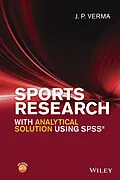A step-by-step approach to problem-solving techniques using SPSS® in the fields of sports science and physical education
Featuring a clear and accessible approach to the methods, processes, and statistical techniques used in sports science and physical education, Sports Research with Analytical Solution using SPSS® emphasizes how to conduct and interpret a range of statistical analysis using SPSS. The book also addresses issues faced by research scholars in these fields by providing analytical solutions to various research problems without reliance on mathematical rigor.
Logically arranged to cover both fundamental and advanced concepts, the book presents standard univariate and complex multivariate statistical techniques used in sports research such as multiple regression analysis, discriminant analysis, cluster analysis, and factor analysis. The author focuses on the treatment of various parametric and nonparametric statistical tests, which are shown through the techniques and interpretations of the SPSS outputs that are generated for each analysis. Sports Research with Analytical Solution using SPSS® also features:
* Numerous examples and case studies to provide readers with practical applications of the analytical concepts and techniques
* Plentiful screen shots throughout to help demonstrate the implementation of SPSS outputs
* Illustrative studies with simulated realistic data to clarify the analytical techniques covered
* End-of-chapter short answer questions, multiple choice questions, assignments, and practice exercises to help build a better understanding of the presented concepts
* A companion website with associated SPSS data files and PowerPoint® presentations for each chapter
Sports Research with Analytical Solution using SPSS® is an excellent textbook for upper-undergraduate, graduate, and PhD-level courses in research methods, kinesiology, sports science, medicine, nutrition, health education, and physical education. The book is also an ideal reference for researchers and professionals in the fields of sports research, sports science, physical education, and social sciences, as well as anyone interested in learning SPSS.
Autorentext
J. P. Verma, PhD, is Professor of Statistics and Director of the Center for Advanced Studies at Lakshmibai National Institute of Physical Education. Dr. Verma is an active researcher and expert in data analysis and sports statistics and has conducted many workshops on research methodology, research designs, multivariate analysis, statistical modeling, and data analysis for students in management, physical education, social science, and economics. He is the author of seven additional books including Repeated Measures Design for Empirical Researchers and Statistics for Exercise Science and Health with Microsoft® Office Excel®, both published by Wiley.
Inhalt
Preface xv
About the Companion Website xviii
Acknowledgments xix
1 Introduction to Data Types and SPSS Operations 1
1.1 Introduction 1
1.2 Types of data 2
1.2.1 Qualitative Data 2
1.2.2 Quantitative Data 3
1.3 Important definitions 4
1.3.1 Variable 4
1.4 Data Cleaning 4
1.5 Detection of Errors 5
1.5.1 Using Frequencies 5
1.5.2 Using Mean and Standard Deviation 5
1.5.3 Logic Checks 5
1.5.4 Outlier Detection 5
1.6 How to Start Spss? 6
1.6.1 Preparing Data File 7
1.7 Exercise 10
1.7.1 Short Answer Questions 10
1.7.2 Multiple Choice Questions 11
2 Descriptive Profile 14
2.1 Introduction 14
2.2 Explanation of Various Descriptive Statistics 16
2.2.1 Mean 16
2.2.2 Variance 16
2.2.3 Standard Error of Mean 17
2.2.4 Skewness 17
2.2.5 Kurtosis 18
2.2.6 Percentiles 19
2.3 Application of Descriptive Statistics 19
2.3.1 Testing Normality of Data and Identifying Outliers 20
2.4 Computation of Descriptive Statistics Using Spss 25
2.4.1 Preparation of Data File 25
2.4.2 Defining Variables 26
2.4.3 Entering Data 26
2.4.4 SPSS Commands 26
2.5 Interpretations of the Results 29
2.6 Developing Profile Chart 31
2.7 Summary of Spss Commands 33
2.8 Exercise 33
2.8.1 Short Answer Questions 33
2.8.2 Multiple Choice Questions 34
2.9 Case Study on Descriptive Analysis 36
3 Correlation Coefficient and Partial Correlation 41
3.1 Introduction 41
3.2 Correlation Matrix and Partial Correlation 43
3.2.1 Product Moment Correlation Coefficient 43
3.2.2 Partial Correlation 45
3.3 Application of Correlation Matrix and Partial Correlation 46
3.4 Correlation Matrix with Spss 46
3.4.1 Computation in Correlation Matrix 46
3.4.2 Interpretations of Findings 51
3.5 Partial Correlation with Spss 51
3.5.1 Computation of Partial Correlations 52
3.5.2 Interpretation of Partial Correlation 55
3.6 Summary of the Spss Commands 56
3.6.1 For Computing Correlation Matrix 56
3.6.2 For Computing Partial Correlations 57
3.7 Exercise 57
3.7.1 Short Answer Questions 57
3.7.2 Multiple Choice Questions 57
3.7.3 Assignment 60
3.8 Case Study on Correlation 60
4 Comparing Means 65
4.1 Introduction 65
4.2 OneSample tTest 66
4.2.1 Application of OneSample tTest 67
4.3 TwoSample tTest for Unrelated Groups 67
4.3.1 Assumptions While Using tTest 67
4.3.2 Case I: TwoTailed Test 68
4.3.3 Case II: Right Tailed Test 68
4.3.4 Case III: Left Tailed Test 69
4.3.5 Application of TwoSample t-Test 70
4.4 Paired tTest for Related Groups 70
4.4.1 Case I: TwoTailed Test 71
4.4.2 Case II: Right Tailed Test 71
4.4.3 Case III: Left Tailed Test 72
4.4.4 Application of Paired tTest 73
4.5 OneSample tTest with Spss 73
4.5.1 Computation in tTest for Single Group 74
4.5.2 Interpretation of Findings 77
4.6 TwoSample tTest for Independent Groups with Spss 78
4.6.1 Computation in TwoSample tTest 79
4.6.2 Interpretation of Findings 83
4.7 Paired tTest for Related Groups with Spss 85
4.7.1 Computation in Paired tTest 86
4.7.2 Interpretation of Findings 89
4.8 Summary of Spss Commands for tTests 90
4.8.1 OneSample tTest 90
4.8.2 TwoSample tTest for Independent Groups 90
4.8.3 Paired tTest 91
4.9 Exercise 91
4.9.1 Short Answer Questions 91
...
